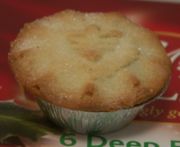A mince pie or mince tart[1] is a traditional British sweet pastry, usually consumed during the Christmas and New Year period.
Contents |
Description of Mince pie
These small pies, usually between 2 and 3 inches in diameter (5 - 7.5 centimetres), can be made using either sweet shortcrust pastry or puff pastry. The American version of the mince pie can be large (8-10 inches or 20-25 centimeters) and able to serve many people.
The origin of the word 'mincemeat' is often of interest, especially as it does not appear to contain any meat whatsoever. Up to Victorian times, the mince(meat) pie would have actually have been a spiced meat pie with some dried fruit. It has evolved to the point where the only meat in the pie is in the form of suet, a historical throwback. The filling is nowadays made from fruit mincemeat (fruitmince to North Americans) containing dried fruit such as raisins, currants, cherries, apricot, candied peel; spices such as cinnamon or nutmeg; nuts such as walnuts or chopped almonds; suet; and some kind of alcohol, usually either brandy or rum. Although no longer a meat pie, the mince pie is suitable for vegetarians only if the suet is replaced by vegetable fat.
Once cooked, the pie is finished off with a delicate dusting of either caster sugar or icing sugar on top.
History of Mince pie
The origins of the mince pie begins with the medieval pastry, chewette which was either fried or baked. The "chewette" actually contained liver or chopped meat mixed with boiled eggs and ginger. Dried fruit and sweet ingredients would be added to the chewette's filling for variety. By the 16th century 'mince' or shred pie was considered a Christmas specialty. In the mid-17th century the liver and chopped meat was replaced by suet and meat products were no longer generally used in the 'mince' by the 19th century in both North America and Great Britain though traditional suet pies are still made it is no longer the dominant form. (Davidson, 1999)
Folklore and Traditions of Mince pie
Folklore states that mince pies are a favourite food of Father Christmas, and that one or two should be left on a plate at the foot of the chimney (along with a small glass of brandy or sherry, and a carrot for the reindeer) as a thank-you for stockings well-filled.
English tradition demands that the mince meat mixture should only be stirred in a clockwise direction. To stir it anticlockwise is to bring bad luck for the coming year.
Tradition also says that one should make a wish whilst eating one's first mince pie of the festive season, and that mince pies should always be eaten in silence.
Eating at least one mince pie on each of the twelve days of Christmas is thought by some people to bring luck for the coming year.
Mince pies should traditionally have a star on top, to represent the Christmas Star which led the shepherds and Magi to the baby Jesus in Bethlehem.
Variations of Mince pie
Other variations include the mincemeat tart, similar in form and taste, save for the lack of a pastry top, as is the case for all kinds of tart. In the United States, mince pies are often classified as mincemeat tarts, although this usage would be considered erroneous by most Britons.
Mincemeat turnovers (a kind of sweet pastry similar to a Cornish pasty) are often made with leftover pastry and mincemeat, and can be consumed with custard, cream or ice-cream.
A Flies graveyard is the name given in Northern Ireland to a flatter variation also known as a currant square.
Trivia of Mince pie
- Mince pies is also cockney rhyming slang for 'eyes' (usually shortened to 'minces' or 'mincers').
- In New Zealand mince pies have meat in them, and sometimes they have cheese in them as well.
- The Guinness World Record holder for the fastest eating of three mince pies, 2.5" in diameter and commercially available, is Barry Donovan of Suffolk, UK, and stands at 1 minute 23 seconds as of February 13th, 2006.
References of Mince pie
- Davidson, Alan. Oxford Companion to Food (1999). "Mince Pie", p. 507 ISBN 0-19-211579-0
Notes of Mince pie
- ^ Although not strictly a tart in that it is not open-topped, it is often called a tart in reference to sweetness.
Categories: Christmas food
|



